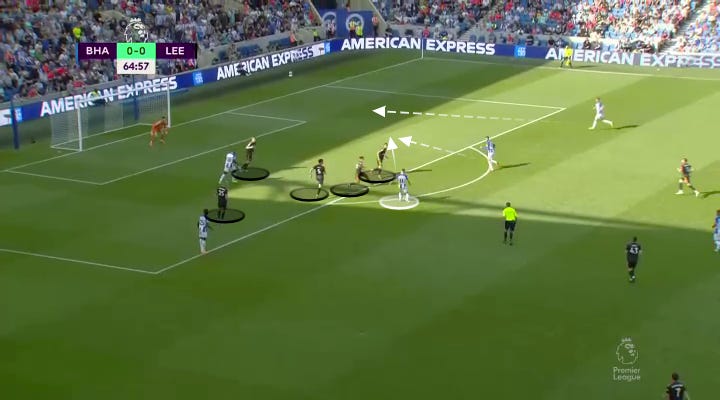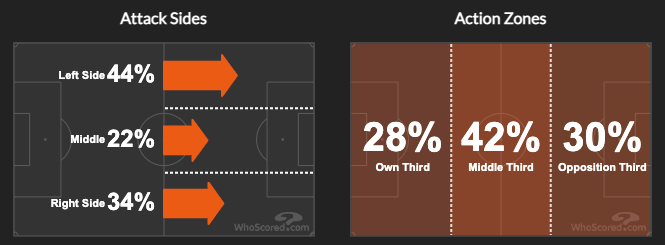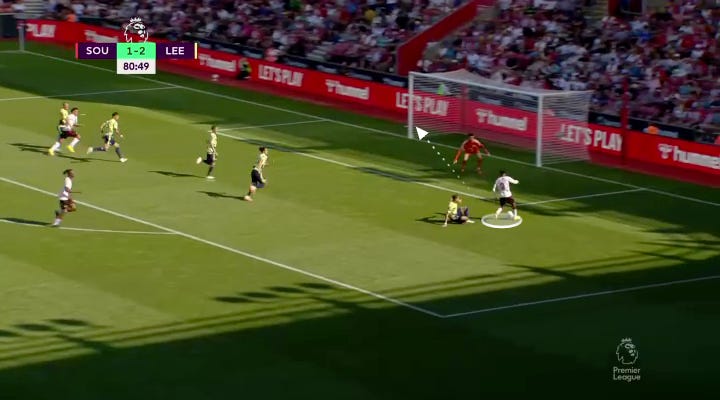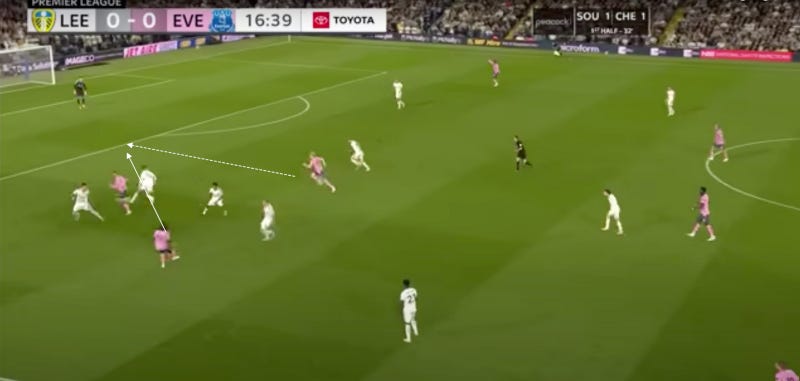A quick, assumption-filled look at what to expect from Leeds
Before writing a preview like this, I usually try to go back and rewatch most (or all) of the team's matches, but in this case: I already wrote a damn BBQ this week, and for whatever reason, I tend to watch a lot of Leeds anyway.
So what follows is a more presumptuous look at what to expect from Leeds on Sunday. An attempt at a side dish, rather than a full BBQ spread, so to speak.
As usual, though, I couldn't keep myself from regaling my own ignorance and diving into some rabbit holes. Join me!
An overview
Leeds United: a storied club who in recent years came to worship an Argentine who was replaced by an American looking to make them play German.
After an eventful first few months in charge, new manager Jesse Marsch’s plan came together in the 3–0 romp of Chelsea. On display was a relentless, plucky, attacking, direct, pressing form of football that induces mistakes and puts them in the net. They proudly ran 11 kilometers farther than their opponent.
Previously-underwhelming Rodrigo looked opportunistic, the new midfield looked solid and occasionally dazzling, and new addition Brendan Aaronson looked every bit the ideal fit for the vision, running and then running and then running some more.
Aaronson picks Mendy’s pocket before swaggily no-looking it home.
The system has its updates from Bielsa (moving to a 4–2–3–1, going zonal, improving on set pieces, and just being more practical overall) but has retained a few of the familiar issues, among them: signs of burnout, missed chances, and a lack of in-game schematic flexibility.
After Chelsea, the follow-up act has been less impressive, with 0 wins in the last 5 matches. The form hasn’t been all bad, and in fact has regular jolts of electricity. A 1–1 draw against Everton was (oddly) one of the more thrilling games of the year. A 5–2 loss to Brentford fell on the other side of the spectrum, with Toney nailing one of the coldest hat-tricks you’ll ever see.
This duality showed up last week against Palace. Leeds was dominant and aggressive for about 20 minutes, but when the game slowed down after Palace scored a set piece equalizer, Leeds had trouble feeling out the game and looked increasingly unmoored. Eventually, the Eagles came to dictate play and win 2–1.
Heading into a matchup at Elland Road, where the purgatorial home side is nonetheless undefeated, here are a few things for Arsenal fans to look out for on Sunday.
A 4–2–3–1 in possession
Schematically, if not talent-wise, the team has much in common with the Liverpool squad that Arsenal just faced, with Klopp’s recent updates in tow: a 4–2–3–1 with flexible, swarming forwards, two holding midfielders, and wide passing triangles with fullbacks.
Again, these are more overarching thoughts than true analyses:
Backline: They are thin on talent and depth back here. Koch and Struijk have been the standouts, with Struijk doing a reverse Ben White and kicking out more to LB to make up for a lack of options out there. He’s been good, but that’s magnified the problems at LCB, where they’ve been either middling (Cooper) or disastrous (Llorente). Firpo may return from injury this week, and Kristensen is evolving in his first year for the Peacocks in front of Ayling and Drameh: fast and strong and shooty. He had his strongest game against Palace, really disrupting Zaha, but his side has also given up a good deal of chances.
Midfield: A pretty locked-in Adams and Roca make up a double-pivot midfield, with one of them usually dropping pretty deep to help with buildup. They’ve been pretty good and active.
Forwards: The forwards play narrow and flexible. Harrison has been pretty locked in on the left side. There’s a bit of a squad composition problem otherwise: Aaronson looks best out wide, but so does Sinisterra — who was such a savvy signing and has flashed a couple elite strikes. Rodrigo has played in the middle 10 where he hasn’t shined (shone?). With the Rodrigo-Bamford duo struggling, Marsch may consider dropping Rodrigo to the bench and using him as a striker sub.
Striker: Bamford’s 17-goal campaign feels like ages ago. He’s often been hurt and is playing himself back into form. Against Palace, he simultaneously passed the fitness eye test and looked rusty. He excels at positioning but can be clumsy with finishing chances. Behind him, they’ve got Rodrigo, Gelhardt, and occasionally Klich.
The only real schematic change they ever make is occasionally moving to a 4–4–2 when down, with one of the backup strikers joining in the attack.
High intensity, short sequences
Their pressing stats are extreme. In the 22/23 Premier League, Marsch’s side features the:
Highest intensity line (7.66 PPDA)
Highest number of pressures (151.3 per 90)
Highest success rate of pressures (49.8%)
Highest number of defensive duels in the league (76.77)
Highest tackles per game (23.3)
Highest number of fouls (13.45 per 90)
This volume of pressure leads to the shortest sequences in the league. The Analyst defines sequences as “passages of play which belong to one team and are ended by defensive actions, stoppages in play or a shot.”
As you’ll see, the average Leeds sequence is only 7.05 seconds (no jokes, please). They want to win possession as quickly as possible, and then pass it quickly, directly, and progressively in the direction of the goal.
This style was on full display in the first goal at Selhurst. Four separate counter-pressing actions led to a ridiculous, rugged Aaronson dribble, shot, and Struijk rebound goal.
In many of the other standard ways, they're solidly mid-pack: goals, goals against, shots, shots against, set pieces, aerial duels, etc. It's an accurate reflection of their talent level.
Unnatural in standard buildup
You know how F1 cars are wound so tight that if they sit in the pits for five seconds too long, the brake discs catch fire? Leeds is kind of like that.
When the game slows down, they’re less fluid, and look to do anything to kick up the intensity. They have the fewest 10-pass sequences (42) and the fewest build-up attacks (6) in the league.
When they do effectively build up, it’s often through the midfield and then off onto the left side, where Jack Harrison and Pascal Struijk have been two of their more reliable performers.
They have the highest % of attacks from the left in the Premier League, with 44%:
Struggles against the dribble
Because of the sheer volume of challenges they offer, they are bound to get dribbled around a lot. The stats bare this out:
Most shots off the dribble in the PL (2.75 per 90)
Highest number of dribbled pasts in the PL, by 3 (13.3 per 90)
Contrast that with Arsenal, who are the best volume dribbling team in the league (with 104 successes) and have the highest success percentage (68.4%). It’s not a skill matchup that favors the home side.
Threaded passes
Statistically, they don’t concede a high amount of overall throughballs, but they have given them up in key moments.
Here's an example. As Southhampton looked to mount a comeback from 2–0 down, the Leeds team is leaning ball-side.
Fresh off the bench, Mara dribbles from the left, attracts attention, and threads a ball around back…
…it goes past a doubling-back Harrison and to Walker-Peters, who slots it into the far post.
Another throughball was played in the Everton match, with Iwobi (🙏🏻) finding a cutting Anthony Gordon for the goal.
Ball-hawking can be exploited
As noted in the above goals, their direct defensive style comes with risks. Opponents can invite attention in holdup play and then pass it to incomers, which is a style of play that comes naturally to Arsenal. This is particularly acute in transition.
Below, Brighton has used a long ball to progress the ball up the field to Welbeck, who attracted a hive, and dumped it to Troussard, who also attracted attention.

Southampton also exploited this in the first goal of their comeback:
By breaking the press, dribbling to attract attention, then crossing, two runners are left wide open. Aribo takes about 10 seconds to get a shot off and still scores.
A battle of attrition
Marsch caused a minor stir by questioning the training methods of the demigod that preceded him:
“The injury issues had a lot to do with the training methodologies, the players were over-trained. That led them to being physically, mentally, psychologically and emotionally in a difficult place to recover from week-to-week and game-to-game.”
System-based-fatigue may be rearing its head again. Particularly in the recent matches after a 29-day break in action, Leeds can come out of the gates hot — and then lose a bit of intensity as the game wears on.
Doing 90%-intensity challenges in their system can often be fatal to their gameplan, as their players are strewn all over the place, and their tackles aren’t getting home to the same degree.
As you see above, they give up 50% of their goals after minute 61. While teams are always more likely to score late, this is still a lot.
If Arsenal can withstand the early barrage, they should be in a good position to win. The odds are in their favor: Arsenal have yet to concede a goal in the first 30 minutes.
🔥 In conclusion 🔥
I'm frankly not sure how conclusive any of this is, but I hope it adds to the context of your watch on Sunday.
If one were dabbling in the trade of expectation management, this does have a few of the characteristics of a trap game. A rested, aggressive, mistake-inducing opponent is hungry for a result at home — while Arsenal is coming off a midweek trip to the Arctic which featured their most lethargic performance of the year, albeit one with every caveat imaginable.
Much more likely, this comes down to a) composure and b) letting talent prevail. If Arsenal is patient and not forced into numerous sloppy mistakes like Chelsea, there's every reason to believe their dribbling, press-resistance, and massive overall talent differential should lead to a comfortable result.
Onward.
And happy grilling everybody.
🔥











